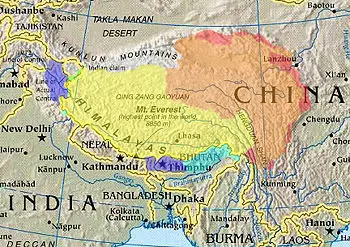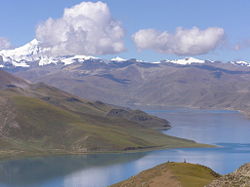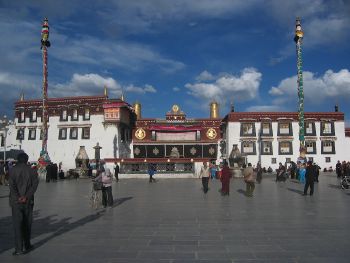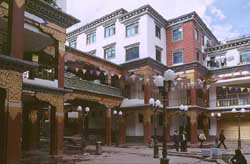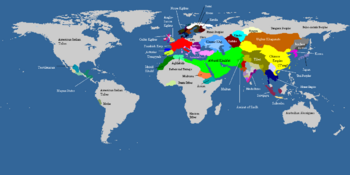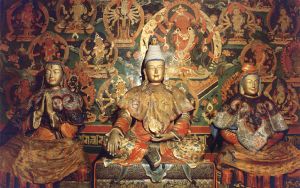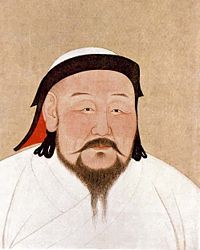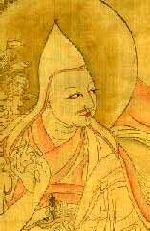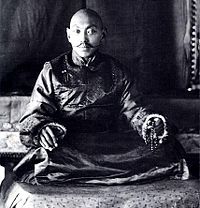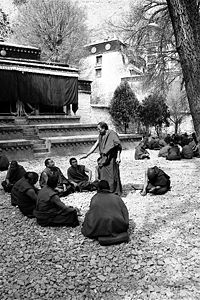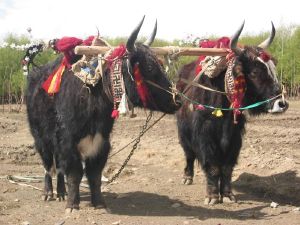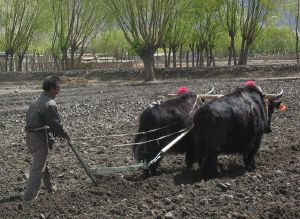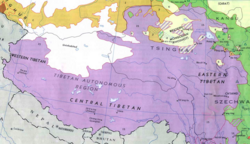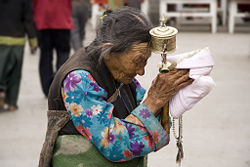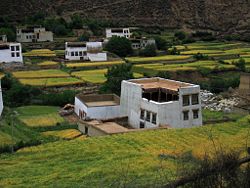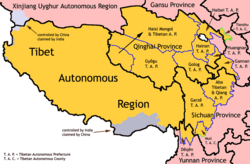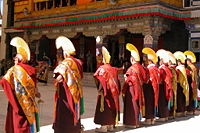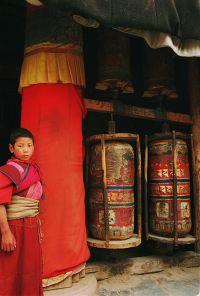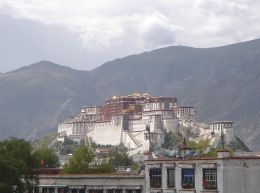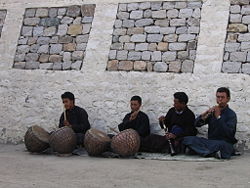Difference between revisions of "Tibet" - New World Encyclopedia
Mike Butler (talk | contribs) |
Mike Butler (talk | contribs) |
||
| Line 67: | Line 67: | ||
When the People's Republic of China (PRC) refers to Tibet, it means the [[Tibet Autonomous Region]] (TAR): a [[province of China|province]]-level entity which includes [[Arunachal Pradesh]] (which used to be part of Tibet but is an Indian state set up by India after Indian occupation). The TAR covers the [[Dalai Lama]]'s former domain, consisting of Ü-Tsang and western Kham, while Amdo and eastern Kham are part of [[Qinghai]], [[Gansu]], [[Yunnan]], and [[Sichuan]]. | When the People's Republic of China (PRC) refers to Tibet, it means the [[Tibet Autonomous Region]] (TAR): a [[province of China|province]]-level entity which includes [[Arunachal Pradesh]] (which used to be part of Tibet but is an Indian state set up by India after Indian occupation). The TAR covers the [[Dalai Lama]]'s former domain, consisting of Ü-Tsang and western Kham, while Amdo and eastern Kham are part of [[Qinghai]], [[Gansu]], [[Yunnan]], and [[Sichuan]]. | ||
| − | The difference in definition is a major source of dispute. The distribution of Amdo and eastern Kham into surrounding provinces was initiated by the [[Yongzheng Emperor]] of Qing Dynasty of China which exercised complete sovereignty over Tibet during the eighteenth century and has been continuously maintained by successive Chinese governments. Tibetan exiles, in turn, consider the maintenance of this arrangement from the | + | The difference in definition is a major source of dispute. The distribution of Amdo and eastern Kham into surrounding provinces was initiated by the [[Yongzheng Emperor]] of Qing Dynasty of China which exercised complete sovereignty over Tibet during the eighteenth century and has been continuously maintained by successive Chinese governments. Tibetan exiles, in turn, consider the maintenance of this arrangement from the eighteenth century as part of a divide-and-rule policy. |
==Geography== | ==Geography== | ||
Revision as of 20:13, 24 July 2007
| Tibetan areas designated by the PRC.[1] | |||||||||
| Tibet Autonomous Region (actual control).[2] | |||||||||
| Claimed by India as part of Aksai Chin.[3] | |||||||||
| Claimed (not controlled) by the PRC as part of the TAR.[4] | |||||||||
| Other historically/culturally-Tibetan areas.[5] | |||||||||
Tibet (older spelling Thibet; Tibetan: བོད་; Wylie: Bod; Lhasa dialect IPA: [pʰø̀ʔ]; Simplified and Traditional Chinese: 西藏, Hanyu Pinyin: Xīzàng; also referred to as 藏区 (Simplified Chinese), 藏區 (Traditional Chinese), Zàngqū is a plateau region in Central Asia and the indigenous home to the Tibetan people.
With an average elevation of 16,000 feet, (4900 meters) it is the highest region on Earth and is commonly referred to as the "Roof of the World."
Tibet has been controlled by the People's Republic of China since 1950, is also officially claimed by the Republic of China (Taiwan). The government of the People's Republic of China and the Government of Tibet in Exile disagree over when Tibet became a part of China, and whether this incorporation into China is legitimate according to international law.
Definitions of Tibet
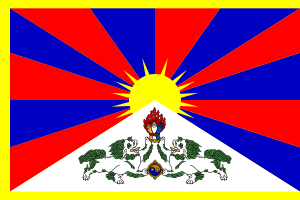
When the Government of Tibet in Exile and the Tibetan refugee community abroad refer to Tibet, they mean the areas consisting of the traditional provinces of Amdo, Kham, and Ü-Tsang, but excluding Sikkim, Bhutan, and Ladakh that have also formed part of the Tibetan cultural sphere.
When the People's Republic of China (PRC) refers to Tibet, it means the Tibet Autonomous Region (TAR): a province-level entity which includes Arunachal Pradesh (which used to be part of Tibet but is an Indian state set up by India after Indian occupation). The TAR covers the Dalai Lama's former domain, consisting of Ü-Tsang and western Kham, while Amdo and eastern Kham are part of Qinghai, Gansu, Yunnan, and Sichuan.
The difference in definition is a major source of dispute. The distribution of Amdo and eastern Kham into surrounding provinces was initiated by the Yongzheng Emperor of Qing Dynasty of China which exercised complete sovereignty over Tibet during the eighteenth century and has been continuously maintained by successive Chinese governments. Tibetan exiles, in turn, consider the maintenance of this arrangement from the eighteenth century as part of a divide-and-rule policy.
Geography
Located on the Tibetan Plateau, the world's highest region, Tibet is bordered on the north and east by China, on the west by the Kashmir Region of India and on the south by Nepal, Bangladesh and Bhutan. Tibet occupies about 471,700 square miles (1,221,600 square kilometers) on the high Plateau of Tibet surrounded by enormous mountains.
The Ch’iang-t’ang in the north extends more than 800 miles (1300km) across with an average elevation of 15,000 feet (4500 meters) above sea level. It has brackish lakes and no river systems there. The plateau descends in elevation towards the east. Mountain ranges in the south-east create a north- south barrier to travel and communication.
The Kunlun Mountains, with its highest peak Mu-tzu-t’a-ko reaching 25,338 feet (7723 meters) form a border to the north. The Himalaya mountains, one of the youngest mountain ranges in the world at only four million years old, form the western and southern border — the highest peak is Mount Everest, which rises to 29,035 feet (8850 meters) on the Tibet–Nepal border. North of Ma-fa-mu Lake and stretching east is the Kang-ti-ssu Range, with several peaks, exceeding 20,000 feet. The Brahmaputra River, which flows across southern Tibet to India, separates this range from the Himalayas.
The Indus River, known in Tibet as the Shih-ch'üan Ho, has its source in western Tibet near the sacred Mount Kailas, and flows west across Kashmir to Pakistan. The Hsiang-ch'üan River flows west to become the Sutlej River in western India, the K'ung-ch'üeh River eventually join the Ganges River, and the Ma-ch'üan River flows east and, after joining the Lhasa River, forms the Brahmaputra River. The Salween River flows from east-central Tibet, through Yunnan to Myanmar. The Mekong River has its source in southern Tsinghai as two rivers—the Ang and Cha—which join near the Tibet border to flow through eastern Tibet and western Yunnan to Laos and Thailand. The Yangtze River arises in southern Tsinghai.
Lakes T'ang-ku-la-yu-mu, Na-mu, and Ch'i-lin are the three largest lakes and are located in central Tibet. In western Tibet are two adjoining lakes, Ma-fa-mu Lake, sacred to Buddhists and Hindus, and Lake La-ang.
The climate is dry nine months of the year, and average snowfall is only 18 inches, due to the rain shadow effect whereby mountain ranges prevent moisture from the ocean from reaching the plateaus. Western passes receive small amounts of fresh snow each year but remain traversable all year round. Low temperatures are prevalent throughout these western regions, where bleak desolation is unrelieved by any vegetation beyond the size of low bushes, and where wind sweeps unchecked across vast expanses of arid plain. The cool dry air means grain can be stored for 50 to 60 years, dried meat will last for a year, and epidemics are rare.
Northern Tibet is subject to high temperatures in the summer and intense cold in the winter. The seasonal temperature variation is minimal, with the greatest temperature differences occurring during a 24-hour period. Lhasa, at an elevation of 11,830 feet, has a maximum daily temperature of 85°F (30°C) and a minimum of -2°F (-19°C).
The arid climate of the windswept Ch'iang-t'ang supports little except grasses. Plant life in the river valleys and in the south and southeast includes willows, poplars, conifers, teak, rhododendrons, oaks, birches, elms, bamboo, sugarcane, babul trees, thorn trees, and tea bushes. The leaves of the lca-wa, khumag, and sre-ral, which grow in the low, wet regions, are used for food. Wildflowers include the blue poppy, lotus, wild pansy, oleander, and orchid.
The forests have tigers, leopards, bears, wild boars, wild goats, stone martens (a kind of cat), langurs, lynx, jackals, wild buffaloes, pha-ra (a small jackal), and gsa' (a small leopard). The high grasslands and dry bush areas have brown bears, wild and bighorn sheep, mountain antelope, musk deer, wild asses, wild yaks, snakes, scorpions, lizards, and wolves. Water life includes types of fish, frog, crab, otter, and turtle. Birds include the jungle fowl, mynah, hawk, the gull, crane, sheldrake, cinnamon teal, and owls. Natural hazards include earthquakes, landslides, and snow.
Lhasa is Tibet's traditional capital and the capital of the Tibet Autonomous Region. Lhasa contains the world heritage site the Potala Palace and Norbulingka, the residences of the Dalai Lama, and a number of significant temples and monasteries which are deeply engrained in its history including Jokhang and Ramoche Temple.Shigatse is the country's second largest city, west of Lhasa. Gyantse, Chamdo are also amongst the largest. Other cities in historic Tibet include, Nagchu, Nyingchi, Nedong, Barkam, Sakya, Gartse, Pelbar, and Tingri; in Sichuan, Kangding (Dartsedo); in Qinghai, Jyekundo or Yushu, Machen, Lhatse, and Golmud.
History
Chinese and the "proto-Tibeto-Burman" language may have split sometime before 4000 B.C.E., when the Chinese began growing millet in the Yellow River valley while the Tibeto-Burmans remained nomads. Tibetan split from Burman around 500 C.E.
Zhang Zhung culture
Prehistoric Iron Age hill forts and burial complexes have been found on the Chang Tang plateau but the remoteness of the location is hampering archaeological research. The initial identification of this culture is as the Zhang Zhung culture which is described in ancient Tibetan texts and is known as the original culture of the Bön religion. According to Annals of Lake Manasarowar, at one point the Zhang Zhung civilization, which started sometime before 1500 B.C.E., comprised 18 kingdoms in the west and northwest portion of Tibet, centered around sacred Mount Kailash. At that time the region was warmer.
The Tibetan Empire
.
Tibet first enters history in the Geography of Ptolemy under the name batai (βαται), a Greek transcription of the indigenous name Bod. Tibet next appears in history in a Chinese text where it is referred to as fa. The first incident from recorded Tibetan history which is confirmed externally occurred when King Namri Lontsen sent an ambassador to China in the early seventh century.
Early Tibet was divided into princedoms, which in the sixth century were consolidated under a king, Gnam-ri srong-brtsan (570 — 619 C.E.), who commanded 100,000 warriors. His son Songtsän Gampo (604–650 C.E.), the 33rd King of Tibet, united parts of the Yarlung River Valley and is credited with expanding Tibet's power and with inviting Buddhism to Tibet. In 640 he married Princess Wencheng, the niece of the powerful Chinese Emperor Taizong of Tang China. Songtsen Gampo, defeated the Zhang Zhung in 644 C.E.
Tibet divided
The reign of Langdarma (838-842) was plagued by external troubles. The Uyghur state to the North collapsed under pressure from the Kirghiz in 840, and many displaced persons fled to Tibet. Langdarma was assassinated in 842. The Tibetan empire collapsed, either as the result of war of succession, or war between rival generals. Allies of one posthumous heir controlled Lhasa, while allies of the other went to Yalung. Nyima-Gon, a representative of the ancient Tibetan royal house founded the first Ladakh dynasty, in the Kashmir region, to the east of present day Ladakh. Central rule was largely nonexistent over the Tibetan region from 842 to 1247, and Buddhism declined in central Tibet, surviving surreptitiously in the region of Kham.
A son of the king of the western Tibet Kingdom of Guge became a Buddhist monk and was responsible for inviting the renowned Indian pandit Atisha to Tibet in 1042 thus ushering in the Chidar (Phyi dar) phase of Buddhism there. Tibetan scholar Dkon-mchog rgyal-po established the Sakya Monastery in Lhokha in 1073. Over the next two centuries Sakya monastery grew to a position of prominence in Tibetan life and culture. At this time, some monasteries began practising a tradition whereby a deceased lama (head of the monastery) was succeeded by a boy judged to be his reincarnation.
Mongol sovereignty
The Mongol khans had ruled northern China by conquest since 1215, as emperors of the Yuan Dynasty. In 1240, the Mongols, investigating an option to attack China from the west, marched into central Tibet and attacked several monasteries. Köden, younger brother of Mongol ruler Güyük Khan, invited the leader of the Sakya sect, to come to his capital and formally surrender Tibet to the Mongols. The Sakya lama arrived in Kokonor with his two nephews, Drogön Chögyal Phagpa (1235-80) and Chana Dorje (1239-1267) (Phyag-na Rdo-rje) (1239-67) in 1246. Köden recognized the Sakya lama as temporal ruler of Tibet in 1247. This event marks the incorporation of Tibet into China, according to modern Chinese historians. Pro-Tibetan historians argue that China and Tibet remained two separate units within the Mongol Empire..
Kublai Khan, who was elected Qaghan in 1260 following the death of his brother Möngke, named Drogön Chögyal Phagpa “state preceptor” his chief religious official, in Tibet. In 1265, Drogön Chögyal Phagpa returned to Tibet and tried to impose Sakya hegemony with the appointment of Shakya Bzang-po (a long time servant and ally of the Sakyas) as the Dpon-chen ('great administrator') over Tibet in 1267. A census was conducted in 1268 and Tibet was divided into 13 myriarchies. In 1270, Phagpa was named Dishi ('imperial preceptor'), and his position as ruler of Tibet was reconfirmed.
Sakya rule continued into the middle of the fourteenth century, although it was challenged by a revolt of the Drikung Kagyu sect with the assistance of Hülegü Khan of the Ilkhanate in 1285. The revolt was suppressed in 1290 when the Sakyas and eastern Mongols burned Drikung Monastery and killed 10,000 people.
Phag-mo-gru-pa dynasty
The collapse of the Mongol Yuan dynasty in 1368 led to the overthrow of the Sakya in Tibet. When the native Chinese Ming dynasty evicted the Mongols, Tibet regained its independence, and for more than 100 years the Phag-mo-gru-pa line governed in its own right. Buddhism revived. Literary activity was intense. Monasteries were built and decorated by Chinese craftsmen. In 1435, the lay princes of Rin-spungs, ministers of Gong-ma, and patrons of the Karma-pa sect, rebelled and by 1481 had seized control of the Phag-mo-gru court.
Yellow Hat sect
The rigorous Buddhist reformist Tsong-kha-pa, who had studied with the leading teachers of the day, formulated his own doctrine, emphasizing the moral and philosophical teachings of Atisha over the magic and mysticism of Sakya. In 1409, he founded a monastery at Dga'-ldan, noted for strict monastic discipline, which appealed to people weary of rivalry and strife between wealthy monasteries. After his death, devoted and ambitious followers built around his teaching and prestige what became the Dge-lugs-pa, or Yellow Hat sect.
The Dalai Lama lineage
The Mongolian ruler Altan Khan bestowed the title of “Dalai Lama” upon Sonam Gyatso, the third head of the Gelugpa Buddhist sect, in 1578, thus reviving the patron-priest relationship that had existed between Kublai Khan and 'Phags-pa.
"Dalai" means "ocean" in Mongolian, and "Lama" is the Tibetan equivalent of the Sanskrit word "guru", and is commonly translated to mean "spiritual teacher". Gyatso was an abbot at the Drepung monastery who was widely considered the most eminent lama of his time. Although Sonam Gyatso became the first lama to hold the title "Dalai Lama", due to the fact that he was the third member of his lineage, he became known as the "third Dalai Lama". The previous two titles were conferred posthumously upon his earlier incarnations. The Dalai Lama is believed to be the embodiment of a spiritual emanation of the bodhisattva—Avalokitesvara, the mythic progenitor of Tibetans. Succession passes to a child, born soon after the death of a Dalai Lama, believed to have received the spirit of the deceased.
Fifth Dalai Lama
The fourth Dalai Lama supposedly reincarnated in Mongol Altan Khan's family. Mongol forces entered Tibet to push this claim, opposed by the Karma-pa sect and Tibet's secular aristocracy. The fourth Dalai Lama died in 1616. New Oyrat Mongol leader Güüshi Khan invaded Tibet in 1640. In 1642, Güüshi enthroned the Fifth Dalai Lama as ruler of Tibet.
Lobsang Gyatso, the fifth Dalai Lama, (1617-1682) was the first Dalai Lama to wield effective political power over central Tibet. He is known for unifying Tibet under the control of the Geluk school of Tibetan Buddhism, after defeating the rival Kagyu and Jonang sects, and the secular ruler, the prince of Shang, in a prolonged civil war. His efforts were successful in part because of aid from Gushi Khan. The Jonang monasteries were either closed or forcibly converted, and that school remained in hiding until the latter part of the twentieth century. The fifth Dalai Lama initiated the construction of the Potala Palace in Lhasa, and moved the center of government there from Drepung.
Manchu sovereignty
The Ch'ing, or Manchu dynasty was installed in China in 1644. The Manchu wanted good relations with Tibet because of the Dalai Lama's prestige among the Mongols. Meanwhile, Tibet clashed with Bhutan in 1646 and 1657, and with Ladakh up to 1684.
The Manchus did not find out about the death of the Fifth Dalai Lama (in 1682), and the appearance of his supposed reincarnation, until 1696. Infuriated, Manchu Emperor K’ang-hsi (who reigned 1661–1722) found an ally in Mongol Lha-bzang Khan, the fourth successor of Güüshi, who sought to assert rights as king in Tibet. The behaviour of the sixth Dalai Lama (1683-1706), a poetry-writing libertine, provided an excuse for Lha-bzang Khan, in 1705, to kill minister regent Sangs-rgyas rgya-mtsho and depose the Dalai Lama as a spurious reincarnation. Fearing Mongol control of Tibet, in 1720 Manchu troops drove out the Mongols, thus gaining a titular sovereignty over Tibet, leaving representatives and a small garrison in Lhasa, and government in the hands of the Dalai Lamas. Manchu troops quelled a civil war in Tibet in 1728, restored order after the assassination of a political leader in 1750, and drove out Gurkhas, who had invaded from Nepal in 1792. Chinese contact helped shape the Tibetan bureaucracy, army, and mail service. Chinese customs influenced dress, food, and manners.
British interest
The first Europeans to arrive in Tibet were Portuguese missionaries in 1624, who built a church. Two Jesuit missionaries, Johannes Gruber and Albert D'Orville, reached Lhasa in 1661, and. The eighteenth century brought more Jesuits and Capuchins from Europe who gradually met opposition from Tibetan lamas who finally expelled them from Tibet in 1745. In 1774, a Scottish nobleman George Bogle came to Shigatse to investigate trade for the British East India Company, introducing the first potato crop into Tibet. All foreigners except Chinese were excluded from Tibet after 1792.
In 1865 Great Britain began secretly mapping Tibet. Trained Indian surveyor-spies disguised as pilgrims or traders counted their strides on their travels across Tibet and took readings at night.
British colonial officials in India attempted to secure a foothold in Tibet, who saw the region as a trade route to China, then as a way to counter Russian advances towards India. In 1904, a British diplomatic mission, led by Colonel Francis Younghusband and accompanied by a large military escort, forced its way through to Lhasa. But on his way to Lhasa, Younghusband killed 1300 Tibetans in Gyangzê because the natives were in fear of what kind of unequal treaty the British would offer the Tibetans. The 13th Dalai Lama fled to China. A treaty was concluded between Britain and Tibet, and then between Britain and China in 1906, that recognized Chinese sovereignty over Tibet.
Chinese sovereignty resisted
The Anglo-Chinese convention encouraged China to invade Tibet in 1910. The 13th Dalai Lama fled again, this time to India. But after the Chinese Revolution in 1911–12, the Tibetans expelled all the Chinese and declared their independence. All Chinese officials and troops were expelled from the country by 1913.
A convention at Simla in 1914 provided for an autonomous Tibet, and for Chinese sovereignty in the region called Inner Tibet. The Chinese government repudiated the agreement, and in 1918, strained relations between Tibet and China exploded into armed conflict. Efforts to conciliate the dispute have failed, and fighting flared up in 1931. The Dalai Lamas continued to govern Tibet as an independent state.
The subsequent outbreak of World War I and Chinese Civil War caused the Western powers and the infighting factions of China proper to lose interest in Tibet, and the 13th Dalai Lama ruled undisturbed until his death in 1933.
In 1935, the 14th Dalai Lama, Tenzin Gyatso was born in Amdo in eastern Tibet and was recognized as the latest reincarnation. He was taken to Lhasa in 1937 where he was later given an official ceremony in 1939. During the 1940s during World War II, two Austrian mountaineers, Heinrich Harrer and Peter Aufschnaider came to Lhasa, where Harrer became tutor and consort to the young Dalai Lama giving him a sound knowledge of western culture and modern society, until he was forced to leave with the Chinese invasion in 1950.
Chinese invade
In October 1950, Communist Chinese troops invaded Tibet. The regency invested the 14th Dalai Lama, although he was only 15 years old. Poorly equipped Tibetan troops were soon crushed. An appeal by the Dalai Lama to the United Nations was denied, while Great Britain and India offered no help. A Tibetan delegation was summoned to China. In May 1951, they signed a dictated treaty that gave the Dalai Lama authority in domestic affairs, Chinese control of Tibetan foreign and military affairs, and for the return from China of the Tibetan Buddhist spiritual leader, the Panchen Lama, allegedly a communist partisan. The Communist Chinese military entered Lhasa in October, and the Panchen Lama arrived there in April 1952.
Chinese rule
During 1952 the Chinese built airfields and military roads. A purge of anti-Communists was reportedly carried out early in 1953. India recognized Tibet as part of China in 1954 and withdrew its troops from two Tibetan frontier trading posts. The Dalai Lama was elected a vice-president of the National People's Congress, the Chinese legislative body.. A committee was set up in 1956 to prepare a constitution, the Dalai Lama was named chairman, and the Panchen Lama first vice-chairman.
An uprising broke out in Amdo and eastern Kham in June 1956. The resistance, supported by the US-American CIA, eventually spread to Lhasa. It was crushed by 1959. During this campaign, tens of thousands of Tibetans were killed. The 14th Dalai Lama and other government principals fled to exile in India, but isolated resistance continued in Tibet until 1969 when the CIA abruptly withdrew its support.
Although the Panchen Lama remained a virtual prisoner, the Chinese set him as a figurehead in Lhasa, claiming that he headed the legitimate Government of Tibet since the Dalai Lama had fled to India. In 1965, the area that had been under the control of the Dalai Lama's government from the 1910s to 1959 (U-Tsang and western Kham) was set up as an Autonomous Region. The monastic estates were broken up and secular education introduced.
During the Cultural Revolution, the Chinese Red Guards inflicted a campaign of organized vandalism against cultural sites in the entire PRC, including Tibet's Buddhist heritage. Some young Tibetans joined in the campaign of destruction, voluntarily due to the ideological fervour that was sweeping the entire PRC and involuntarily due to the fear of being denounced as enemies of the people. Of the several thousand monasteries in Tibet, over 6500 were destroyed, only a handful of the most important, religiously or culturally, monasteries remained without major damage according to the Chinese source. And hundreds of thousands of Buddhist monks and nuns were forced to return to secular life.
In 1989, the Panchen Lama was finally allowed to return to Shigatse, where he addressed a crowd of 30,000 and described what he saw as the suffering of Tibet and the harm being done to his country in the name of socialist reform under the rule of the PRC in terms reminiscent of the petition he had presented to Chinese Premier Zhou Enlai in 1962.. Five days later, he mysteriously died of a massive heart attack at the age of 50.
In 1995 the Dalai Lama named six-year-old Gedhun Choekyi Nyima as the 11th Panchen Lama without Chinese approval, while the PRC named another child, Gyancain Norbu in conflict. Gyancain Norbu was raised in Beijing and has appeared occasionally on state media. Tibetans reject the PRC-selected Panchen Lama. Gedhun Choekyi Nyima and his family have gone missing - widely believed to be imprisoned by China - and under a hidden identity for protection and privacy according to the PRC.
The PRC continues to portray its rule over Tibet as an unalloyed improvement, but foreign governments continue to make occasional protests about aspects of PRC rule in Tibet because of frequent reports of human rights violation in Tibet by groups such as Human Rights Watch. All governments, however, recognize the PRC's sovereignty over Tibet today, and none have recognized the Government of Tibet in Exile in India.
Government and politics
Before the Chinese occupied Tibet in 1951, the country had a theocratic government with the Dalai Lama the religious and temporal head. From 1951, the Chinese relied on military control working towards regional autonomy, which was granted in 1965. Since then, Tibet has been an autonomous region of China. The region is divided into the municipality of Lhasa, directly under the jurisdiction of the regional government, and prefectures (Qamdo, Shannan, Xigazê, Nagqu, Ngari, and Nyingchi), which are subdivided into counties.
The army comprises regular Chinese troops under a Chinese commander, stationed at Lhasa. There are military cantonments in major towns along the borders with India, Nepal, and Bhutan. Tibetans have been forcibly recruited into regular, security, and militia regiments.
Economy
The economy of Tibet is dominated by subsistence agriculture, and is that of a poor country. Due to limited arable land, livestock raising is the primary occupation mainly on the Tibetan Plateau, among them are sheep, cattle, goats, camels, yaks and horses. However the main crops grown are barley, wheat, buckwheat, rye, potatoes and assorted fruits and vegetables and in recent years the economy has begun evolving into a multiple structure with agriculture and tertiary industry developing side by side. The PRC government exempts Tibet from all taxation and provides 90 percent of Tibet's government expenditures. Tibet's economy depends on Beijing.
Tourism
Tibet's tourism has grown., especially after the finish of Qingzang Railway in July 2006, Tibet received 2.5 million tourists in 2006, including 150 thousands foreigners. Increased interest in Tibetan Buddhism has helped make tourism an increasingly important sector, and this is actively promoted by the authorities. Tourists buy handicrafts — hats, jewelry (silver and gold), wooden items, clothing, quilts, fabrics, Tibetan rugs and carpets.
Qinghai-Tibet Railway
The Qinghai-Tibet Railway which links the region to Qinghai in China proper was opened in 2006. The Chinese government claims that the line will promote the development of impoverished Tibet. But opponents argue the railway will harm Tibet since it would bring in more Han Chinese residents, the country's dominant ethnic group, who have been migrating steadily to Tibet over the last decade, bringing with them their popular culture. Opponents say the large influx of Han Chinese will ultimately extinguish the local culture. Others argue that the railway will damage Tibet's fragile ecology.
As an autonomous region of China, data on imports and exports is not readily available, and any that is derives from state publications issued for publicity purposes. According to PRC figures, Tibet's GDP in 2001 was 13.9 billion yuan (US$1.8-billion). Tibet's economy has had an average growth of 12 percent per year from 2000 to 2006, a figure that corresponded to the five-year goal issued at the start of the period.
The per capita GDP reached 10,000 renminbi (mainland China unit of currency) in 2006 for the first time. That would convert to $1233, which would place Tibet between Mali (164th) and Nigeria (165th) on the International Monetary Fund list. By comparison, the PRC per capita GDP is $7598, or 87th. Tibet is a poor part of China.
Demographics
Historically, the population of Tibet consisted of primarily ethnic Tibetans. Other ethnic groups in Tibet include Menba (Monpa), Lhoba, Mongols and Hui Chinese. According to tradition the original ancestors of the Tibetan people, as represented by the six red bands in the Tibetan flag, are: the Se, Mu, Dong, Tong, Dru and Ra.
The issue of the proportion of the Han Chinese population in Tibet is a politically sensitive one. The Central Tibetan Administration says that the People's Republic of China has actively swamped Tibet with Han Chinese migrants in order to alter Tibet's demographic makeup.
The death toll in Tibet since the invasion of the People's Liberation Army in 1950 has been estimated at a median of 600,000.[6]
View of the Tibetan exile community
Between the 1960s and 1980s, many prisoners (over 1 million, according to Harry Wu) were sent to laogai camps in Amdo (Qinghai), where they were then employed locally after release. Since the 1980s, increasing economic liberalization and internal mobility has also resulted in the influx of many Han Chinese into Tibet for work or settlement, though the actual number of this floating population remains disputed.
The Government of Tibet in Exile gives the number of non-Tibetans in Greater Tibet as 7.5 million (as opposed to 6 million Tibetans), and claims this is as a result of an active policy of demographically swamping the Tibetan people and further diminishing any chances of Tibetan political independence, and as such, to be in violation of the Geneva Convention of 1946 that prohibits settlement by occupying powers.[citation needed]
The Government of Tibet in Exile questions all statistics given by the PRC government, since they do not include members of the People's Liberation Army garrisoned in Tibet, or the large floating population of unregistered migrants.[citation needed] The Qinghai-Tibet Railway (Xining to Lhasa) is also a major concern, as it is believed to further facilitate the influx of migrants.
View of the People's Republic of China
The PRC government does not view itself as an occupying power and has vehemently denied allegations of demographic swamping. The PRC also does not recognize Greater Tibet as claimed by the government of Tibet in Exile, saying that the idea was engineered by foreign imperialists as a plot to divide China amongst themselves, (Mongolia being a striking precedent, gaining independence with Soviet backing and subsequently aligning itself with the Soviet Union) and that those areas outside the TAR were not controlled by the Tibetan government before 1959 in the first place, having been administered instead by other surrounding provinces for centuries.[7]
The PRC gives the number of Tibetans in Tibet Autonomous Region as 2.4 million, as opposed to 190,000 non-Tibetans, and the number of Tibetans in all Tibetan autonomous entities combined (slightly smaller than the Greater Tibet claimed by exiled Tibetans) as 5.0 million, as opposed to 2.3 million non-Tibetans. In the TAR itself, much of the Han population is to be found in Lhasa. Population control policies like the one-child policy only apply to Han Chinese, not to minorities such as Tibetans [citation needed].
Jampa Phuntsok, chairman of the TAR, has also said that the central government has no policy of migration into Tibet due to its harsh high-altitude conditions, that the 6% Han in the TAR is a very fluid group mainly doing business or working, and that there is no immigration problem.[8]
| Major ethnic groups in Greater Tibet by region, 2000 census. | |||||||
|---|---|---|---|---|---|---|---|
| Total | Tibetans | Han Chinese | others | ||||
| Tibet Autonomous Region: | 2,616,329 | 2,427,168 | 92.8% | 158,570 | 6.1% | 30,591 | 1.2% |
| - Lhasa PLC | 474,499 | 387,124 | 81.6% | 80,584 | 17.0% | 6,791 | 1.4% |
| - Qamdo Prefecture | 586,152 | 563,831 | 96.2% | 19,673 | 3.4% | 2,648 | 0.5% |
| - Shannan Prefecture | 318,106 | 305,709 | 96.1% | 10,968 | 3.4% | 1,429 | 0.4% |
| - Xigazê Prefecture | 634,962 | 618,270 | 97.4% | 12,500 | 2.0% | 4,192 | 0.7% |
| - Nagqu Prefecture | 366,710 | 357,673 | 97.5% | 7,510 | 2.0% | 1,527 | 0.4% |
| - Ngari Prefecture | 77,253 | 73,111 | 94.6% | 3,543 | 4.6% | 599 | 0.8% |
| - Nyingchi Prefecture | 158,647 | 121,450 | 76.6% | 23,792 | 15.0% | 13,405 | 8.4% |
| Qinghai Province: | 4,822,963 | 1,086,592 | 22.5% | 2,606,050 | 54.0% | 1,130,321 | 23.4% |
| - Xining PLC | 1,849,713 | 96,091 | 5.2% | 1,375,013 | 74.3% | 378,609 | 20.5% |
| - Haidong Prefecture | 1,391,565 | 128,025 | 9.2% | 783,893 | 56.3% | 479,647 | 34.5% |
| - Haibei AP | 258,922 | 62,520 | 24.1% | 94,841 | 36.6% | 101,561 | 39.2% |
| - Huangnan AP | 214,642 | 142,360 | 66.3% | 16,194 | 7.5% | 56,088 | 26.1% |
| - Hainan AP | 375,426 | 235,663 | 62.8% | 105,337 | 28.1% | 34,426 | 9.2% |
| - Golog AP | 137,940 | 126,395 | 91.6% | 9,096 | 6.6% | 2,449 | 1.8% |
| - Gyêgu AP | 262,661 | 255,167 | 97.1% | 5,970 | 2.3% | 1,524 | 0.6% |
| - Haixi AP | 332,094 | 40,371 | 12.2% | 215,706 | 65.0% | 76,017 | 22.9% |
| Tibetan areas in Sichuan province | |||||||
| - Ngawa AP | 847,468 | 455,238 | 53.7% | 209,270 | 24.7% | 182,960 | 21.6% |
| - Garzê AP | 897,239 | 703,168 | 78.4% | 163,648 | 18.2% | 30,423 | 3.4% |
| - Muli AC | 124,462 | 60,679 | 48.8% | 27,199 | 21.9% | 36,584 | 29.4% |
| Tibetan areas in Yunnan province | |||||||
| - Dêqên AP | 353,518 | 117,099 | 33.1% | 57,928 | 16.4% | 178,491 | 50.5% |
| Tibetan areas in Gansu province | |||||||
| - Gannan AP | 640,106 | 329,278 | 51.4% | 267,260 | 41.8% | 43,568 | 6.8% |
| - Tianzhu AC | 221,347 | 66,125 | 29.9% | 139,190 | 62.9% | 16,032 | 7.2% |
| Total for Greater Tibet: | |||||||
| With Xining and Haidong | 10,523,432 | 5,245,347 | 49.8% | 3,629,115 | 34.5% | 1,648,970 | 15.7% |
| Without Xining and Haidong | 7,282,154 | 5,021,231 | 69.0% | 1,470,209 | 20.2% | 790,714 | 10.9% |
This table includes all Tibetan autonomous entities in the People's Republic of China, plus Xining PLC and Haidong P. The latter two are included to complete the figures for Qinghai province, and also because they are claimed as parts of Greater Tibet by the Government of Tibet in exile.
P = Prefecture; AP = Autonomous prefecture; PLC = Prefecture-level city; AC = Autonomous county
Excludes members of the People's Liberation Army in active service.
Source: Department of Population, Social, Science and Technology Statistics of the National Bureau of Statistics of China (国家统计局人口和社会科技统计司) and Department of Economic Development of the State Ethnic Affairs Commission of China (国家民族事务委员会经济发展司), eds. Tabulation on Nationalities of 2000 Population Census of China (《2000年人口普查中国民族人口资料》). 2 vols. Beijing: Nationalities Publishing House (民族出版社), 2003. (ISBN 7-105-05425-5)
Culture

Religion
Tibetan Buddhism
Religion is extremely important to the Tibetans; Tibet is the traditional center of Tibetan Buddhism, a distinctive form of Vajrayana, which is also related to the Shingon Buddhist tradition in Japan. Tibetan Buddhism is practiced not only in Tibet but also in Mongolia, the Buryat Republic, the Tuva Republic, and in the Republic of Kalmykia. Tibet is also home to the original spiritual tradition called Bön.
Islam
In Tibetan cities, there are also small communities of Muslims, known as Kachee (Kache), who trace their origin to immigrants from three main regions: Kashmir (Kachee Yul in ancient Tibetan), Ladakh and the Central Asian Turkic countries. Islamic influence in Tibet also came from Persia. After 1959 a group of Tibetan Muslims made a case for Indian nationality based on their historic roots to Kashmir and the Indian government declared all Tibetan Muslims Indian citizens later on that year.[9] There is also a well established Chinese Muslim community (gya kachee), which traces its ancestry back to the Hui ethnic group of China. It is said that Muslim migrants from Kashmir and Ladakh first entered Tibet around the 12th century. Marriages and social interaction gradually led to an increase in the population until a sizable community grew up around Lhasa.[citation needed]
The Potala Palace, former residence of the Dalai Lamas, is a World Heritage Site, as is Norbulingka, former summer residence of the Dalai Lama.
During the suppression of pro-independence forces in the 1950s, and during the Cultural Revolution in the 1960s, most historically significant sites in Tibet were vandalized or totally destroyed.
Since 2002, Tibetans in exile have allowed a Miss Tibet beauty contest in spite of concerns that this event is considered a Western influence. The beauty contest is condemned by the Tibetan government in exile.[citation needed]
Buddhist monasteries in Tibet
Notable monasteries:
- Ani Tsankhung Nunnery
- Changzhu Temple
- Dorje Drak
- Drepung Monastery
- Drigung Monastery
- Dzogchen Monastery
- Ganden Monastery
- Jokhang
- Kumbum Monastery (Kham)
- Labrang Monastery
- Menri Monastery
- Namgyal Monastery
- Narthang Monastery
- Palcho Monastery
- Ralung Monastery
- Ramoche Temple
- Sakya Monastery
- Sanga Monastery
- Sera Monastery
- Shalu Monastery
- Shechen Monastery
- Surmang Monastery
- Tashilhunpo
- Tsurphu Monastery
- Yerpa
Tibetan art
Tibetan representations of art are intrinsically bound with Tibetan Buddhism and commonly depict deities or variations of Buddha in various forms from bronze Buddhist statues and shrines, to highly colorful thangka paintings and mandalas.
Architecture
Tibetan architecture contains Oriental and Indian influences, and reflects a deeply Buddhist approach. The Buddhist wheel, along with two dragons, can be seen on nearly every Gompa in Tibet. The design of the Tibetan Chörtens can vary, from roundish walls in Kham to squarish, four-sided walls in Ladakh.
The most unusual feature of Tibetan architecture is that many of the houses and monasteries are built on elevated, sunny sites facing the south, and are often made out a mixture of rocks, wood, cement and earth. Little fuel is available for heat or lighting, so flat roofs are built to conserve heat, and multiple windows are constructed to let in sunlight. Walls are usually sloped inwards at 10 degrees as a precaution against frequent earthquakes in the mountainous area.
Standing at 117 meters in height and 360 meters in width, the Potala Palace is considered as the most important example of Tibetan architecture. Formerly the residence of the Dalai Lama, it contains over a thousand rooms within thirteen stories, and houses portraits of the past Dalai Lamas and statues of the Buddha. It is divided between the outer White Palace, which serves as the administrative quarters, and the inner Red Quarters, which houses the assembly hall of the Lamas, chapels, 10,000 shrines, and a vast library of Buddhist scriptures.
Music
The music of Tibet reflects the cultural heritage of the trans-Himalayan region, centered in Tibet but also known wherever ethnic Tibetan groups are found in India, Bhutan, Nepal and further abroad. First and foremost Tibetan music is religious music, reflecting the profound influence of Tibetan Buddhism on the culture.
Tibetan music often involves chanting in Tibetan or Sanskrit, as an integral part of the religion. These chants are complex, often recitations of sacred texts or in celebration of various festivals. Yang chanting, performed without metrical timing, is accompanied by resonant drums and low, sustained syllables. Other styles include those unique to the various schools of Tibetan Buddhism, such as the classical music of the popular Gelugpa school, and the romantic music of the Nyingmapa, Sakyapa and Kagyupa schools.
Nangma dance music is especially popular in the karaoke bars of the urban center of Tibet, Lhasa. Another form of popular music is the classical gar style, which is performed at rituals and ceremonies. Lu are a type of songs that feature glottal vibrations and high pitches. There are also epic bards who sing of Tibet's national hero Gesar.
Festivals
Tibet has various festivals which commonly are performed to worship the Buddha throughout the year. Losar is the Tibetan New Year Festival and the Monlam Prayer Festival follows it in the first month of the Tibetan calendar which involves many Tibetans dancing and participating in sports events and sharing picnics.
Cuisine
The most important crop in Tibet is barley, and dough made from barley flour called tsampa, is the staple food of Tibet. This is either rolled into noodles or made into steamed dumplings called momos. Meat dishes are likely to be yak, goat, or mutton, often dried, or cooked into a spicy stew with potatoes. Mustard seed is cultivated in Tibet, and therefore features heavily in its cuisine. Yak yoghurt, butter and cheese are frequently eaten, and well-prepared yoghurt is considered something of a prestige item. Butter tea is very popular to drink and many Tibetans drink up to 100 cups a day.[citation needed]
Tibet in popular culture
In recent years there have been a number of films produced about Tibet, mostly notably Hollywood films such as Seven Years in Tibet, starring Brad Pitt, and Kundun, a biography of the Dalai Lama, directed by Martin Scorsese. Both of these films were banned by the Chinese government because of Tibetan nationalist overtones. Other films include Samsara, The Cup and the 1999 Himalaya, a French-American produced film with a Tibetan cast set in Nepal and Tibet. In 2005, exile Tibetan filmmaker Tenzing Sonam and his partner Ritu Sarin made Dreaming Lhasa, the first internationally recognized feature film to come out of the diaspora to explore the contemporary reality of Tibet. In 2006, Sherwood Hu made Prince of the Himalayas, an adaptation of Shakespeare's Hamlet, set in ancient Tibet and featuring an all-Tibetan cast. Seen also briefly in the 1994 movie The Shadow, starring Alec Baldwin. Kekexili
, or Mountain Patrol, is a film made by National Geographic about a Chinese reporter that goes to Tibet to report on the issue involving the endangerment of Tibetan Antelope.
Gallery
- IMG 1972 Sakya.jpg
Monks at Sakya Monastery
- IMG 1719 Gyantze.jpg
Gyantse
- IMG 1125 Lhasa Sera.jpg
Monks at Sera
- YumbuLhakhang.jpg
Yumbo Lhakang
- Drepung monastery.jpg
Drepung Monastery
- IMG 0839 Yarlong Tsangpo.jpg
Yarlung Tsangpo
- Sera15.JPG
Sera Monastery
- Litang-ninos-c01-f.jpg
Tibetan children in Lithang
- OmManiPadmeHum.jpg
ReferencesISBN links support NWE through referral fees
- ↑ 西藏自治区; 青海省; 四川省; 云南省; 甘肃省 (行政区划网).
- ↑ Tibet at a glance (The Office of Tibet, London; 30 September 1996);
Official web page of Arunachal Pradesh;
China-India Border: Eastern Sector (map produced by the United States Central Intelligence Agency; Perry-Castañeda Library Map Collection, University of Texas at Austin). - ↑ China-India Border: Western Sector (map produced by the United States Central Intelligence Agency; Perry-Castañeda Library Map Collection, University of Texas at Austin);
Official Website of Jammu and Kasmir (Directorate of Information, Jammu and Kashmir Government). - ↑ China-India Border: Eastern Sector (map produced by the United States Central Intelligence Agency; Perry-Castañeda Library Map Collection, University of Texas at Austin);
China Tibet Information Center. - ↑ Kingdom of Bhutan (Bhutan Tourism Corporation Limited);
About Sikkim (Government of Sikkim, Department of Information Technology);
History of Leh (Ladakh Autonomous Hill Development Council). - ↑ Source List and Detailed Death Tolls for the Twentieth Century Hemoclysm
- ↑ Xinhua News report (Chinese)
- ↑ SINA News report (Chinese)
- ↑ Masood Butt, 'Muslims of Tibet', The Office of Tibet, January/February 1994
Further reading
- Allen, Charles (2004). Duel in the Snows: The True Story of the Younghusband Mission to Lhasa. London: John Murray, 2004. ISBN 0-7195-5427-6.
- Bell, Charles (1924). Tibet: Past & Present. Oxford: Clarendon Press.
- Dowman, Keith (1988). The Power-Places of Central Tibet: The Pilgrim's Guide. Routledge & Kegan Paul. London, ISBN 0-7102-1370-0. New York, ISBN 0-14-019118-6.
- Goldstein, Melvyn C.; with the help of Gelek Rimpoche. A History of Modern Tibet, 1913-1951: The Demise of the Lamaist State. Munshiram Manoharlal Publishers (1993), ISBN 81-215-0582-8. University of California (1991), ISBN 0-520-07590-0.
- Grunfeld, Tom (1996). The Making of Modern Tibet. ISBN 1-56324-713-5.
- Gyatso, Palden (1997). "The Autobiography of a Tibetan Monk". Grove Press. NY, NY. ISBN 0-8021-3574-9
- Human Rights in China: China, Minority Exclusion, Marginalization and Rising Tensions, London, Minority Rights Group International, 2007
- McKay, Alex (1997). Tibet and the British Raj: The Frontier Cadre 1904-1947. London: Curzon. ISBN 0-7007-0627-5.
- Norbu, Thubten Jigme; Turnbull, Colin (1968). Tibet: Its History, Religion and People. Reprint: Penguin Books (1987).
- Pachen, Ani; Donnely, Adelaide (2000). Sorrow Mountain: The Journey of a Tibetan Warrior Nun. Kodansha America, Inc. ISBN 1-56836-294-3.
- Parenti, Michael (2004)."Friendly Feudalism: The Tibet Myth".
- Petech, Luciano (1997). China and Tibet in the Early XVIIIth Century: History of the Establishment of Chinese Protectorate in Tibet. T'oung Pao Monographies, Brill Academic Publishers, ISBN 9-00403-442-0.
- Samuel, Geoffrey (1993). Civilized Shamans: Buddhism in Tibetan Societies. Smithsonian ISBN 1-56098-231-4.
- Schell, Orville (2000). Virtual Tibet: Searching for Shangri-La from the Himalayas to Hollywood. Henry Holt. ISBN 0-8050-4381-0.
- Shakya, Tsering (1999). The Dragon in the Land of Snows: A History of Modern Tibet Since 1947. New York: Columbia University Press. ISBN 0-231-11814-7.
- Smith, Warren W. (Jr.) (1996). Tibetan Nation: A History of Tibetan Nationalism and Sino-Tibetan Relations. Boulder, CO: Westview Press. ISBN 0-8133-3155-2.
- Stein, R. A. (1962). Tibetan Civilization. First published in French; English translation by J. E. Stapelton Driver. Reprint: Stanford University Press (with minor revisions from 1977 Faber & Faber edition), 1995. ISBN 0-8047-0806-1.
- Thurman, Robert (2002). Robert Thurman on Tibet. DVD. ASIN B00005Y722.
- Wilby, Sorrel (1988). Journey Across Tibet: A Young Woman's 1900-Mile Trek Across the Rooftop of the World. Contemporary Books. ISBN 0-8092-4608-2.
- Wilson, Brandon (2004). Yak Butter Blues: A Tibetan Trek of Faith. Heliographica. An Imprint of Pilgrim's Tales. ISBN 1-933037-23-7, ISBN 1-933037-24-5.
- Jiawei, Wang (2000). "The Historical Status of China's Tibet". ISBN-7-80113-304-8.
- Tibet wasn't always ours, says Chinese scholar by Venkatesan Vembu, Daily News & Analysis, 22 February 2007
See also
| This article contains Chinese text. Without proper rendering support, you may see question marks, boxes, or other symbols instead of Chinese characters. |
| This article contains Indic text. Without proper rendering support, you may see question marks or boxes, misplaced vowels or missing conjuncts instead of Indic text. |
- Amdo and Kham in eastern Tibet
- Évariste Régis Huc (Abbé Huc) visited Tibet in 1845-1846, and wrote his observations in Souvenirs d'un voyage dans la Tartarie, le Thibet, et la Chine pendant les années 1844-1846.
- Francis Younghusband led a punitive military expedition to Tibet in 1904.
- Alexandra David-Neel visited Lhasa in 1924, and wrote several books about the country and its culture.
- Human rights in the People's Republic of China
- Central Tibetan Administration aka Tibetan Government in Exile
- International Tibet Independence Movement aka Free Tibet Movement
- List of active autonomist and secessionist movements
- Tibetan American
- Seven Years in Tibet
- Kundun
- Tibetan Buddhism
- South Tibet
- Nangpa La killings
- Ladakh
- Baltistan
External links
- Ukraine U.S. Department of State, accessed July 23, 2007.
- Ukraine BBC News Country Profile, accessed July 23, 2007.
- Ukraine Economist.com, accessed July 23, 2007.
Against PRC rule and policies in Tibet
- Tibetan Government in Exile's main web site
- Tibetan Government in Exile's government site
- Students for a Free Tibet's website
For PRC rule and policies in Tibet
- Tibetan History on the China Tibet Information Center of the PRC
- White Paper on Tibetan Culture and Homayk
Apolitical
- Travel guide to Tibet from Wikitravel
Credits
New World Encyclopedia writers and editors rewrote and completed the Wikipedia article in accordance with New World Encyclopedia standards. This article abides by terms of the Creative Commons CC-by-sa 3.0 License (CC-by-sa), which may be used and disseminated with proper attribution. Credit is due under the terms of this license that can reference both the New World Encyclopedia contributors and the selfless volunteer contributors of the Wikimedia Foundation. To cite this article click here for a list of acceptable citing formats.The history of earlier contributions by wikipedians is accessible to researchers here:
The history of this article since it was imported to New World Encyclopedia:
Note: Some restrictions may apply to use of individual images which are separately licensed.
